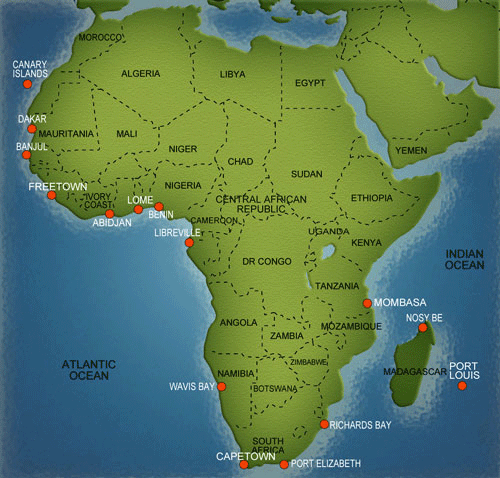11
Mar
With over 90% of Africa’s imports and exports conducted by sea, there is an increasing need for innovation and development in the field of maritime.
Africa covers about 6% of the earth’s total surface. With 38 of its 54 states either coastal or insular in nature, Africa has over a hundred port facilities, a few of which handle 6% of the worldwide water-borne cargo traffic and about 3% of the world’s container traffic.
With over 90% of Africa’s imports and exports conducted by sea, research conducted by Jovago.com reveals the 7 harbours/ports that stand out strategically across the region.
Durban, South Africa
Port of Durban as popularly known is Africa’s most active general cargo port. It is situated a block away from Durban’s central business district and plays a key role in S.A’s economy.
Being Africa’s largest container port, it handles most of the seagoing traffic in comparison to the other ports in South Africa.
This port welcomes about 4,500 vessels yearly and about 8,3000 containers per month, it conducts trade worth over $45billion.According to the Port Management Association of Eastern and Southern Africa, it handled about 44.8 million tonnes of cargo of cargo in 2013-2014.
Mombasa, Kenya
Port Mombasa, often referred to as “the city of merchants” dates back to the times of Portuguese exploration, it has been and remains a busy trading post for the region which could be attributed to its strategic location between South Africa and the Gulf of Aden.
It is a key gateway to East and Central Africa. It provides a direct link to about 80 ports worldwide and a railway line runs therefrom to Uganda and Tanzania.
With 18,000 twenty-foot equivalent units (teu) and a container capacity of about 250,000 teu per year, Mombasa Port now handles about double this volume.
The teu is an inexact unit of cargo capacity used to describe the capacity of container ships and container terminals. It is based on the volume of a 20-foot-long (6.1 m) intermodal container.
Djibouti
Djibouti’s ports are crucial to its geo-strategic importance both in military and economic terms. They serve as a passage for Ethiopian trade and a platform for the transhipment of goods.
This involves the outflow of container and bulk cargo from larger vessels to be redistributed to East Africa and Arabian ports.
It provides a secure regional hub for transhipment and relay of goods. China is also directly involved in the Port of Djibouti through the state-owned China Merchants Group.
Their interest in Djibouti goes beyond the benefits of being involved in East African regional trade rather Djibouti’s position as the only reliable port along the main shipping lanes between Europe and the Gulf and also between Asia and the eastern coast of Africa is essential.
Lagos, Nigeria
Being Nigeria’s economic focal point, Lagos generates a significant portion of the country’s GDP. Port of Lagos, also known as Lagos Port Complex is located at the Apapa area of Lagos, South West Nigeria.
Its operational area consists of berthing, cargo-handling and stacking areas and storage facilities.
This leading port is one of the largest and busiest in Africa, it is administered by the Nigerian Ports Authority and is split into three main sections: Lagos port, in the main channel next to Lagos Island, Apapa Port (site of the container terminal) and Tin Can Port, both located in Badagry Creek.
Abidjan, Ivory Coast
The port of Abidjan is located on a lagoon and is connected to the sea by a 2.8 long km channel. The Abidjan Container Terminal is run jointly by the French Bolloré Africa Logistics and APM Terminals.
Ivory Coast’s economic capital Abidjan boasts of the biggest port in the West African sub-region, which is also the second biggest in Africa with the container storage capacity of 20,000 TEUs and an annual volume of 610,000 TEUs.
The container trans-shipment port was opened in 1951 and its 15 metres deep Vridi Canal allows boats with large draughts to dock in the deep-water port and this gives Abidjan an edge as it has become even more important, receiving the bulk of the country’s industrial activity.
Suez Canal, Egypt
The Suez Canal is 101 miles (163 km) long connecting the Mediterranean Sea with the Gulf of Suez, a northern branch of the Red.
Since its inception in 1869, it has allowed ships to travel between Europe and South Asia without navigating around Africa hence reducing the sea voyage distance between Europe and India significantly.
The Suez Canal Axis Development Project aimed at its expansion and development is currently in planning. The 2014 canal revenue was approximately $5.45 billion which was 6.8 % higher than the previous year.
The 2014 total tonnage was up to 962.7 million tonnes.
Tangier, Morocco
Separated from The Port of Tangier which remains the port for ferries, the Tangier-Med Port, accommodates commercial ships and vessels and can facilitate up to 3.5 million containers.
This was triggered by the expansion of the market and import-export industry, requiring the need to streamline the flow of traffic.
It only opened in 2007, and already it is one of the largest ports on the Mediterranean and in Africa in terms of capacity.
Source: http://businesstech.co.za/news/general/81995/africas-biggest-shipping-ports/
